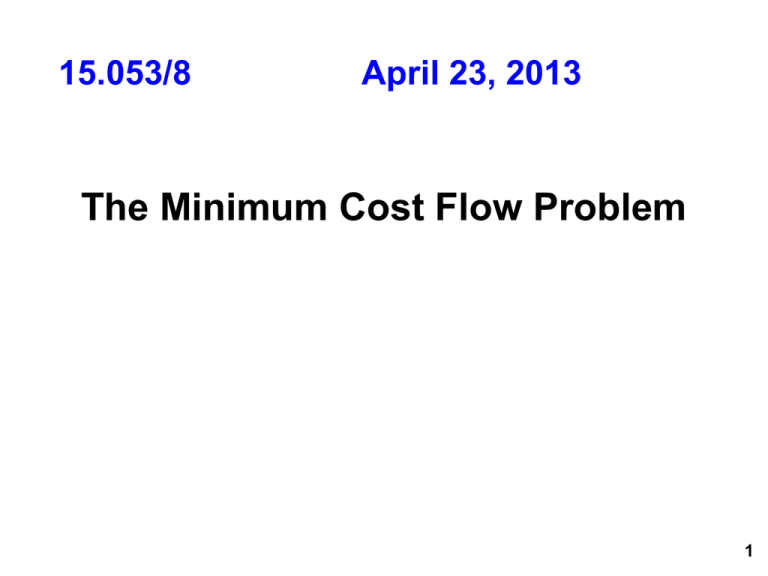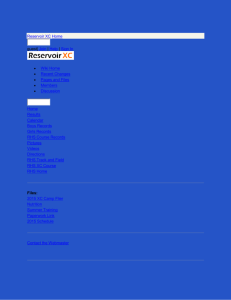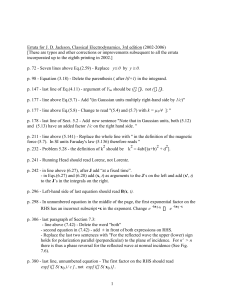
15.053/8
April 23, 2013
The Minimum Cost Flow Problem
1
Quotes of the day
“A process cannot be understood by stopping it.
Understanding must move with the flow of the
process, must join it and flow with it.”
-- Frank Herbert
“No question is so difficult to answer as that to
which the answer is obvious.”
-- George Bernard Shaw
2
Overview of lecture
More examples of networks
Examples of flows
– movement of goods from one location to another.
Why flows is such an important example of linear
and/or integer programs
– integrality property
Coverage of lecture is for broader knowledge
than is covered on the quiz on networks.
3
Networks are everywhere
Physical networks
Time space networks
Connections between concepts
Social networks
Network flows: model movements in networks
4
Road Network
Photo courtesy of Derrick Coetzee on Flickr.
Electrical Network
Public domain image (Wikimedia Commons)
Image removed due to
copyright restrictions.
Boston MBTA
Train Map
Power Grid
Public domain image (EIA.gov)
5
Internet
from wikipedia
Courtesy of the Opte Project, License CC BY.
6
Biological Network
imdevsoftware.wordpress.com
© Creative Data Solutions. All rights reserved. This content is excluded from our Creative
Commons license. For more information, see http://ocw.mit.edu/help/faq-fair-use/.
7
Biological
neural network
Public domain (NIH)
Computer neural
network
Public domain (NASA)
8
Customers demand
centers sinks
Sources:
Plants vendors
ports
Regional warehouses:
Stocking points
Field warehouses:
Stocking points
Supply
Inventory & warehousing
costs
Production/purchase
costs
Transportation costs
Transportation costs
Inventory & warehousing
costs
Image by MIT OpenCourseWare.
Supply chain
9
Train schedule
Public domain image: Paris-Lyon, 1885
10
diagram: systems dynamics
Courtesy of Prof. Jim Hines. Source: 15.875 Applications of System Dynamics, Spring 2004. (MIT OpenCourseWare: Massachusetts Institute of Technology),
http://ocw.mit.edu/courses/sloan-school-of-management/15-875-applications-of-system-dynamics-spring-2004 (Accessed 25 Nov, 2013).
11
Organizational Chart
Public domain (NIH)
Social Networks
© Neil Cummings on Flickr. License CC BY-SA. This content is excluded from our Creative
Commons license. For more information, see http://ocw.mit.edu/help/faq-fair-use/.
12
Flows in networks
Shipping from warehouses to retailers
The min cost flow problem
A remarkable theorem
13
The transportation problem
Warehouse
Supply
From/To
R1
R2
R3
A
40
A
2
5
3
B
50
B
2
4
5
C
60
C
3
4
2
D
50
D
5
2
3
Matrix of linear arc costs
Region
Demand
R1
80
R2
70
R3
50
14
The Transportation Problem
Supply
nodes
40 A
50 B
60 C
50 D
2
4
5
Demand
nodes
2
5
3
3
4
2
5
2
3
1
80
2
70
3
50
The transportation problem
is a min cost flow problem
with the following two
properties:
• All arcs are directed
from “supply nodes”
to “demand nodes.”
• Arcs have costs, but
there is no upper
bound on arc flows.
15
An LP formulation
Let xij = amount shipped from i to j
assigned to task j.
xA1 xA2 xA3 xB1 xB2 xB3 xC1 xC2 xC3 xD1 xD2RHS
xD3
RHS
A
1
1
1
0
0
0
0
0
0
0
0 RHS
0
40
B
0
0 RHS
0
1
1
1
0
0
0
0
0
0
50
C
0
0 RHS
0
0
0
0
1
1
1
0
0
0
60
D
0
0 RHS
0
0
0 RHS
0
0
0
0
1
1
1
50
1
1
0
0
1
0
0
1
0
0
1
0 RHS
0
80
2
0
1
0
0
1
0
0
1
0
0
1 RHS
0
70
3
0
0
1
0
0
1
0
0
1
0
0 RHS
1
50
16
An equivalent formulation
Sometimes it is better to treat supply as positive
and demand as negative.
xA1 xA2 xA3 xB1 xB2 xB3 xC1 xC2 xC3 xD1 xD2RHS
xD3
RHS
A
1
1
1
0
0
0
0
0
0
0
0 RHS
0
40
B
0
0 RHS
0
1
1
1
0
0
0
0
0
0
50
C
0
0 RHS
0
0
0
0
1
1
1
0
0
0
60
D
0
0 RHS
0
0
0 RHS
0
0
0
0
1
1
1
50
1
-1
1
0
0
-1
1
0
0
-1
1
0
0
-1
1
0 RHS
0
-80
80
2
0
-1
1
0
0
-1
1
0
0
-1
1
0
0
-1
1 RHS
0
-70
70
3
0
0
-1
1
0
0
-1
1
0
0
-1
1
0
0 RHS
-1
1
-50
50
17
When supply exceeds demand
Supply
nodes
Demand
nodes
40 A
50 B
60 C
10
50 D
10
10
20
If supply exceeds demand:
• add a dummy node
1
60
2
60
3
50
• Flow into the dummy
node is the slack variable.
dummy
18
Supply/demand constraints
3 2
3 -2
7 1
=
xij = flow in (i, j)
node supply/demands bi
4 -8
Flow out of node i
Flow into node i
bi
Example: Node 4
x42 – x14 – x34 = -8
We always assume that Σ bi = 0.
That is, the available supply equals the required demand.
This is wlog. More on that latter.
19
Formulating a min cost flow problem
3 2
3 -2
7 1
4 -8
Minimize
( i , j )A
xij = flow in (i, j)
node supply/demands bi
arc costs cij
arc capacities uij
cij x ij
x12 x14 x23 x32 x34 x42
1
1
0
0
0
0
-1
0
1
-1
0
-1
0
0
-1
1
1
0
0
-1
0
0
-1
1
RHS
=
=
=
=
7
3
-2
-8
0 ≤ xij ≤ uij
for all arcs
(i, j) ∈ A
20
An LP formulation of the min cost flow problem
2
3
1
4
xij = flow in (i, j)
arc costs cij
arc capacities uij
node supply/demands bi
for j ∈ N
0 ≤ xij ≤ uij
for all arcs (i, j) ∈ A
The amount shipped out of a node minus the
amount shipped in to the node is the supply.
n
b
i 1
i
0
21
A communication problem
The year is 2013, and there is incredible demand for
videos of MIT class lectures . MIT has set up three
sites to handle the incredible load.
The major demand for the lectures are in London and
China. There are some direct links from each of the
three MIT sites, and the lectures can be sent through
two intermediate satellite dishes as well.
Each node has a supply (or a demand) indicating how
much should be shipped from (or to) the node. Each
link (arc) has a unit cost of shipping flow, and a
capacity on how much can be sent per second. What
is the cheapest way of handling the required load?
22
Supplies, Demands, and Capacities
50
-400
200
175
300
200
200
200
150
100
100
0
75
0
150
175
-200
23
Costs per megabyte. And node labels
1
$0
$ .01
6
4
$. 01
$. 01
2
$.01
$.01
$.02
3
$0
$. 03
$. 04
5
7
24
The Supply/Demand Constraints of the LP
1-6 1-4
1
2-4
2-5 3-5
3-7 4-6
4-7 5-6 5-7
1
1
1
1
-1
1
-1
1
-1
1
-1
1
-1
-1
-1
1
-1
-1
-1
=
200
=
300
=
100
=
0
=
0
=
-400
=
-200
There is redundant constraint for the min cost flow problem.
25
The Optimal Flows
50
-400
200
150
300
200
150
175
125
25
100
0
75
0
125
0
-200
26
Which of the following is false?
1. If we consider all of the supply/demand constraints
of a min cost flow problem, then each column has a
coefficient that is 1, a coefficient that is -1, and all
other coefficient are 0.
2. ✓
There is always a feasible solution for a min cost
flow problem.
3. The supplies/demands sum to 0 for a min cost flow
problem that is feasible.
4. At least one of the constraints of the min cost flow
problem is redundant.
27
Mental Break
28
Why study the min cost flow problem
Flows are everywhere
–
–
–
–
–
communication systems
manufacturing systems
transportation systems
energy systems
water systems
Integrality Property
Can be solved efficiently.
Professor Orlin coauthored a textbook on
network flows.
Unifying Problem
–
–
–
–
shortest path problem
max flow problem
transportation problem
assignment problem
© Prentice Hall. All rights reserved. This content is excluded from our Creative Commons
license. For more information, see http://ocw.mit.edu/help/faq-fair-use/.
29
A Remarkable Theorem. (Integrality Theorem)
If the supplies, demands, and capacities of a minimum
cost flow problem are all integral, then every basic
feasible solution is integer valued. Therefore, the
simplex method will provide an integer optimal
solution.
Note: Most linear programs can have fractional solutions.
x + y = 1, x – y = 0.
Unique solution (.5, .5)
Reason: The coefficients in the LHS of the constraints in
the tableau remain as 0, 1 or -1.
Microsoft ®
Excel
30
Which of the following is false about the integrality
theorem for min cost flows?
1.
2.
3.
4.
5.
It is remarkable.
It is in contrast to the fact that most linear programs
are not guaranteed to have integer valued bfs’s.
It is remarkable.
It can be very useful in solving integer programs.
It was
✓ first proved to be true by Professor Orlin.
31
More on the integrality theorem
Valid for LPs in which the coefficients
in each column (ignoring the objective
coefficients and the RHS) have at most
one 1 and at most one -1, with all other
elements being 0.
Does not depend on the costs.
Does depend RHS being integral.
Does depend on upper and lower
bounds on variables being integer.
$.04
3
OK
1.6 4
7
Bad
6
1
Bad
2
u61 = 4.2
32
It is a theorem about basic feasible flows.
Non-basic flows can be fractional.
A network with arc costs.
Suppose uij = 1 for all (i, j)
1
Suppose b(i) = 0 for all i.
1
0
0
2
Optimal Flow 1
cost = 0
1
1
1
2
Optimal Flow 2
cost = 0
2
2
-2
1
.5
.5
2
Optimal Flow 3
cost = 0
33
Which is not needed to guarantee that
each bfs for a minimum cost flow
problem has integer solutions?
1.
Supplies/Demands are
all integer valued
2.
Capacities are integer
valued
3.
Costs
are integer
✓
valued
4.
All the above are
needed.
34
Special cases of the min cost flow problem
Shortest path problem
Maximum flow problem
Assignment problem
35
The shortest path
problem with
nonnegative arc lengths
2
3
5
3
Translation to flow problem:
Node 1 has a supply of 1.
Node 5 has a demand of 1.
1
3
5
The optimal solution will send a
flow of 1 unit along the shortest
path from node 1 to node 5.
3
2
2
3
3
5
4
1
1
4
1
1
Find the shortest path from
node 1 to node 5.
2
3
3
5
-1
36
The Maximum Flow Problem
Directed Graph G = (N, A).
– Source s
– Sink t
– Capacities uij on arc (i,j)
– Maximize the flow out of s, subject to
– Flow out of i = Flow into i, for i ≠ s or t.
4
1
2
1
s
1
2
3
t
3
A Network with arc capacities
1
2
1
s
1
2
t
2
The maximum flow
37
The Assignment Problem
N1
(Persons)
1
1
1
1
10
1 15
2
14
10
19
3
21
10
13
4
13
10
N2
(Tasks)
5
1
6
1
7
1
8
1
The assignment problem is
the special case of
transportation problem in
which all supplies and
demands are 1.
Usually, but not always,
|N1| = |N2|.
Usually, max utility instead
of min cost.
38
An assignment problem
Three MIT hackers have decided to make the
great dome look like R2D2, in honor of the hack
from 5/17/99.
Tasks.
– Putting the sheets on the great dome
– Ladder holder
– Lookout
– Objective: find the optimal allocation of persons to
tasks.
– What is the optimal assignment of hackers to tasks.
39
Hacker
1
10
8
Task 1
9
Hacker
2
5
10
Task 2
5
Hacker
3
9
The arc
numbers
are utilities.
The goal is
to find an
assignment
with
maximum
total utility.
Task 3
40
An LP formulation
Let xij = proportion of time that hacker i is
assigned to task j.
x11 x12 x21 x22 x23 x32 x33
RHS
1
1
0
0
0
0
0
1
Hacker 1
0
0
0
0
1
0
1
0
1
0
0
1
0
1
1
1
Hacker 2
Hacker 3
1
0
1
0
0
0
0
1
Task 1
0
0
1
0
0
0
1
0
0
1
1
0
0
1
1
1
Task 2
Task 3
41
An Application of the Assignment Problem
Suppose that there are moving targets in space.
You can identify each target as a pixel on a radar screen.
Given two successive pictures, identify how the targets have
moved.
This may be
the most
efficient
way of
tracking
items.
42
The matching problem: what is the
maximum number of persons who can be
matched to tasks?
Persons
1
2
3
4
Tasks
5
6
7
8
5
6
7
8
1
0
1
0
0
2
1
0
1
1
3
0
1
0
0
4
0
1
1
1
An adjacency matrix
43
The matching problem
1
2
6
3
7
4
5
6
7
8
1
0
1
0
0
2
1
0
1
1
3
0
1
0
0
4
0
1
1
1
5
8
An adjacency matrix
A matching of cardinality three corresponds to
three 1’s of the adjacency matrix, no two of which
are in the same row or column.
44
Independent 1’s and line covers
5
6
7
8
1
0
1
0
0
Max-Matching Min-Cover
2
1
0
1
1
3
0
1
0
0
4
0
1
1
1
The minimum number
of lines to cover
all of the 1’s of a matrix
is equal to the max
number of 1’s no two
of which are on a line.
An adjacency matrix
45
Matrix rounding
col
sums
.3
0
.4
row
sums
.7
.5
.7
0
1.2
.2
.6
.2
1.0
1.0
1.3
.6
Round coefficients of the matrix up or down so that the
row sums and columns sum are also rounded.
col
sums
x11
x12
x13
x21
x22
x23
x31
x32
x33
|x11 – .3| < 1
|x21 – .5| < 1
|x31 – .2 | < 1
|x11 + x21 + x31 – 1.0 | < 1
46
Application to matrix rounding
row
sums
col
sums
0 ≤ x11 ≤ 1
x12 = 0
0 ≤ x13 ≤ 1
0 or 1
0 ≤ x21 ≤ 1
0 ≤ x22 ≤ 1
x23 = 0
1 or 2
0 ≤ x31 ≤ 1
0 ≤ x32 ≤ 1
0 ≤ x33 ≤ 1
1
1
1 or 2
0 or 1
Round coefficients of the matrix up or down so that the
row sums and columns sum are also rounded.
x11 + x21 + x31 = 1
47
An LP formulation
Let xij = value in row i and column j.
Let r1, r2, c2 and c3 be slack variables.
x11 x12 x13 x21 x22 x23 x31 x32 x33
r1
r2 RHS
c2
c3
RHS
1
1
1
0
0
0
0
0
0
1
0 RHS
0
0
1
0
0 RHS
0
1
1
1
0
0
0
0
1
0
0
2
0
0 RHS
0
0
0
0
1
1
1
0
0
0
0
1
1
0
0
1
0
0
1
0
0
0
0 RHS
0
0
1
0
1
0
0
1
0
0
1
0
0
0 RHS
1
0
2
0
0
1
0
0
1
0
0
1
0
0 RHS
0
1
1
48
Baseball Elimination Problem
Games Games
Won
Left
Bos
82
8
NY
77
8
Balt
80
8
Tor
79
8
Tamp
74
9
Bos
NY
Balt
Tor Tamp
Bos
--
1
4
1
2
NY
1
--
0
3
4
Balt
4
0
--
1
0
Tor
1
3
1
0
3
Tamp
2
4
0
3
0
Has Tampa already been eliminated from winning
in this hypothetical season finale?
http://riot.ieor.berkeley.edu/~baseball/
49
Is there a way for Tampa to be tied for the
lead (or winning) at the end of the season?
Assume that Tampa wins all of their games.
• If they can’t lead the division after winning all of
their games, they certainly can’t lead if they lose
one or more games.
Question: is it possible to assign wins and losses to
all remaining games so that Tampa ends up in first
place?
50
The results if Tampa wins all its games.
Games Games
Won
Left
Bos
82
11
6
NY
77
8
4
Balt
80
8
6
Tor
79
8
5
Tamp
74
83
9
0
Bos
NY
Balt
Tor Tamp
Bos
--
1
7
4
1
2
0
NY
1
--
0
3
4
0
Balt
7
4
0
--
1
0
Tor
1
3
1
0
3
0
Tamp
2
0
4
0
0
3
0
0
Now check to see if the remaining games can
be played so that no team wins more than 83
games.
51
Constraints
Upper bound on the number of games won by
each team (except Tampa).
Each game is won by one of the two teams
playing the game.
The flow on an arc is the number of games won.
52
Flow on (i,j) is interpreted as games won.
1
Red Sox
vs. Yankees
4
Red Sox
vs. Orioles
1
Red Sox
1
Yankees
Red Sox
vs. Blue Jays
3
Yankees
vs. Blue Jays
1
Orioles
vs. Blue Jays
6
10
3
t
Orioles
4
Blue
Jays
53
The optimum flow
1
Red Sox
vs. Yankees
4
Red Sox
vs. Orioles
1
Red Sox
1
1
3
1
3
6
4
10
3
3
t
4
2
Orioles
Yankees
vs. Blue Jays
Orioles
vs. Blue Jays
1
Yankees
3
Red Sox
vs. Blue Jays
1
1
1
Blue
Jays
54
Some Information on the Min Cost Flow Problem
Reference text: Network Flows: Theory,
Algorithms, and Applications by Ahuja, Magnanti,
and Orlin [1993]
15.082J/6.885J: Network Optimization
Polynomial time simplex algorithm (Orlin [1997])
Basic feasible solutions of a minimum cost flow
problem are integer valued (assuming that the data
is integer valued)
Very efficient solution techniques in practice
55
MIT OpenCourseWare
http://ocw.mit.edu
15.053 Optimization Methods in Management Science
Spring 2013
For information about citing these materials or our Terms of Use, visit: http://ocw.mit.edu/terms.





